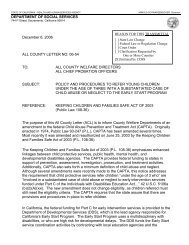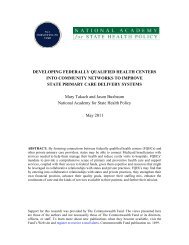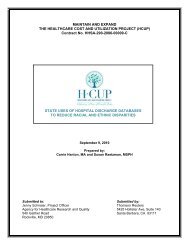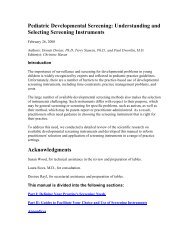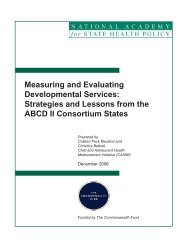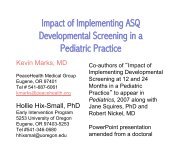Improving Care Coordination, Case Management, and Linkages to
Improving Care Coordination, Case Management, and Linkages to
Improving Care Coordination, Case Management, and Linkages to
Create successful ePaper yourself
Turn your PDF publications into a flip-book with our unique Google optimized e-Paper software.
Introduction <strong>and</strong> Background<br />
All children need health care that moni<strong>to</strong>rs their growth <strong>and</strong> development. Based on knowledge<br />
about the importance of healthy development <strong>to</strong> early school success <strong>and</strong> awareness of the<br />
gaps in achievement between low-income children <strong>and</strong> their more affluent counterparts, families,<br />
professionals, <strong>and</strong> policymakers have given increased attention <strong>to</strong> early childhood development.<br />
Increased poverty among young children raises the stakes for success. 1 A growing body of evidence<br />
suggests that prevention <strong>and</strong> early intervention are substantially less costly than life-long special education<br />
<strong>and</strong> treatment. 2 Through early identification <strong>and</strong> intervention, providers <strong>and</strong> parents can influence<br />
young children’s development <strong>and</strong> readiness <strong>to</strong> learn at school, their risk of certain adult diseases, <strong>and</strong><br />
their future social <strong>and</strong> economic productivity. 3<br />
Across the country, states, providers, <strong>and</strong> communities have undertaken efforts <strong>to</strong> identify young children<br />
in need of early interventions by increasing the number who receive appropriate, objective st<strong>and</strong>ardized<br />
developmental screening. Early childhood developmental screening—at appropriate intervals<br />
with valid instruments—can identify the majority of children who have developmental risks <strong>and</strong> concerns.<br />
Studies show that screening with an objective <strong>to</strong>ol more reliably identifies problems <strong>and</strong> increases<br />
referrals. 4<br />
Although screening is critical <strong>to</strong> the developmental surveillance pediatric primary health care providers<br />
conduct, it does little good for a child unless accompanied by effective referral <strong>and</strong> follow up <strong>and</strong> appropriate<br />
interventions. As providers conduct more screening <strong>and</strong> identify more children in need of followup<br />
services, the weakness of the U.S. child-serving systems <strong>and</strong> inadequacy of linkages among providers<br />
becomes increasingly apparent. It is clear that more must be done <strong>to</strong> assure access <strong>to</strong> the diagnostic<br />
assessment <strong>and</strong> early intervention services essential as follow up <strong>to</strong> screening.<br />
Promising approaches for improving follow up <strong>and</strong> strengthening linkages are underway at the practice,<br />
community, <strong>and</strong> state levels. 5 Many such projects <strong>and</strong> initiatives aim <strong>to</strong> help families benefit from screening<br />
<strong>and</strong> surveillance in pediatric primary care by connecting them <strong>and</strong> their children <strong>to</strong> services <strong>and</strong><br />
supports they need. 6<br />
States play an important role in removing barriers <strong>and</strong> providing support as communities move <strong>to</strong>ward<br />
more integrated services. This paper outlines the opportunities <strong>to</strong> better connect children <strong>and</strong> families<br />
<strong>to</strong> services, barriers that hinder effective coordination <strong>and</strong> linkages, <strong>and</strong> strategies that states can use <strong>to</strong><br />
promote coordination between primary health care providers <strong>and</strong> follow-up medical <strong>and</strong> developmental<br />
services in their communities. It sets the stage for a new ABCD initiative <strong>to</strong> focus on care coordination<br />
<strong>and</strong> linkages <strong>to</strong> support healthy child development.<br />
Ac c e s s <strong>to</strong> developmentAl services is uneven A n d inequitAble<br />
Not all families receive the services they need <strong>to</strong> identify developmental <strong>and</strong> behavioral issues in early<br />
childhood. In the National Survey of Early Childhood Health, less than half of parents of young children<br />
reported that their pediatric primary care provider offered thorough “anticipa<strong>to</strong>ry guidance” related <strong>to</strong><br />
their child’s health <strong>and</strong> development, <strong>and</strong> only 57 percent reported their child’s development had ever<br />
been assessed at a pediatric primary care visit. 7 The survey also identified racial/ethnic disparities in<br />
pediatric primary care providers’ patterns for discussing selected <strong>to</strong>pics with parents. Parents of African-<br />
American <strong>and</strong> Hispanic children report higher rates of unmet need for early childhood development<br />
6<br />
<strong>Improving</strong> <strong>Care</strong> <strong>Coordination</strong>, <strong>Case</strong> <strong>Management</strong>, <strong>and</strong> <strong>Linkages</strong> <strong>to</strong> Service for Young Children: Opportunities for States<br />
National Academy for State Health Policy



